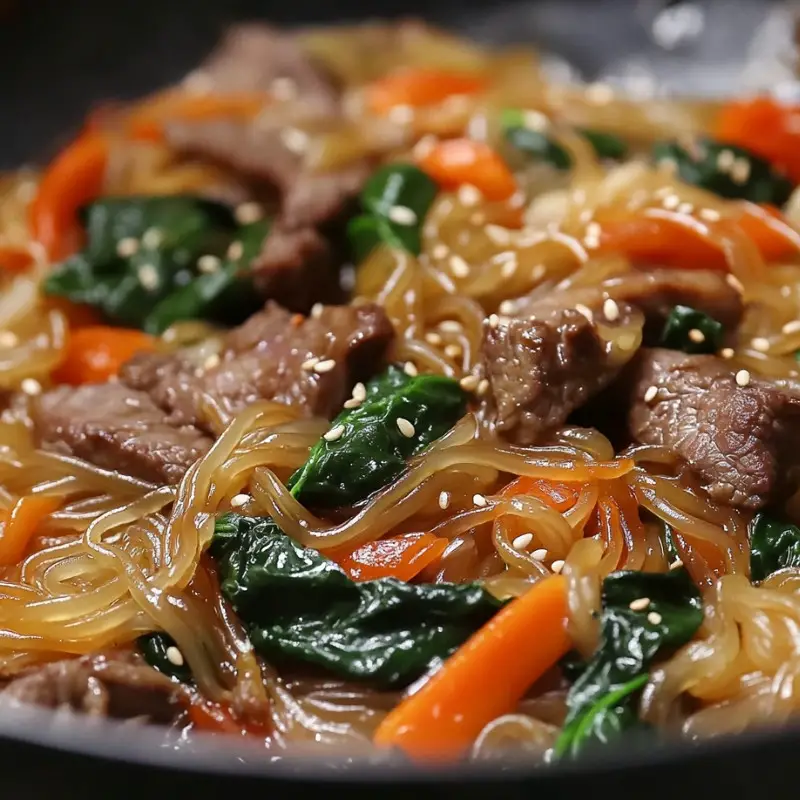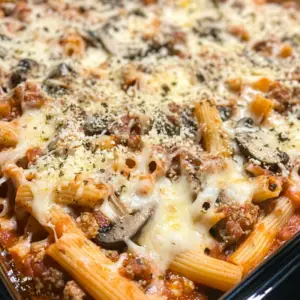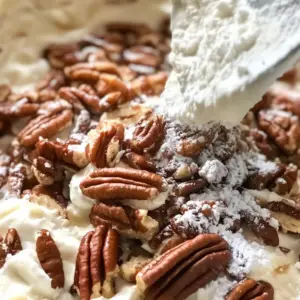
Introduction
Japchae is a beloved Korean dish featuring stir-fried glass noodles made from sweet potato starch. It’s a flavorful, colorful dish that can be enjoyed as a main or side dish, perfect for any occasion with its vibrant mix of vegetables and rich, savory sauce.
Ingredients
Korean sweet potato noodles (dangmyeon): 200g
Beef (thinly sliced): 100g
Spinach: 100g
Carrot (julienned): 70g
Onion (thinly sliced): 80g
Bell pepper (thinly sliced): 70g
Mushrooms (shiitake or button, sliced): 60g
Soy sauce: 60ml
Sugar: 20g
Sesame oil: 15ml
Vegetable oil: 15ml
Garlic (minced): 10g
Sesame seeds: 5g
Salt: to taste
Black pepper: to taste
Prep Time
20 minutes
Cook Time
20 minutes
Total Time
40 minutes
Yield
4 servings
Directions
1. Cook the sweet potato noodles in boiling water for about 7 minutes, or until they are soft. Drain and rinse them under cold water. Toss with sesame oil to prevent sticking and set aside.
2. In a large pan, heat vegetable oil over medium heat. Add the minced garlic and sauté until fragrant. Add the sliced beef, season with a pinch of salt and pepper, and cook until browned. Remove from the pan and set aside.
3. In the same pan, add the vegetables—onions, carrots, bell pepper, and mushrooms. Stir-fry for about 4-5 minutes until the vegetables are soft but still crisp. Add the cooked beef back to the pan.
4. In a separate pot, blanch the spinach briefly in boiling water, then drain and squeeze out excess water. Add it to the pan with the beef and vegetables.
5. Add the cooked noodles to the pan along with soy sauce and sugar. Toss well to combine everything. Adjust seasoning with additional salt and pepper if necessary.
6. Stir-fry everything together for another 3-4 minutes, ensuring the noodles absorb the flavors of the sauce. Sprinkle with sesame seeds before serving.
Detailed Directions and Instructions
Step 1: Prepare the Sweet Potato Noodles
Begin by cooking the Korean sweet potato noodles (dangmyeon) in a pot of boiling water for about 7 minutes until they become soft and tender. Once cooked, drain the noodles and rinse them under cold water. This step helps stop the cooking process and prevents them from becoming sticky. To keep the noodles from clumping together, toss them with sesame oil and set aside.
Step 2: Sauté the Beef
In a large pan, heat vegetable oil over medium heat. Add the minced garlic and sauté until it releases its fragrant aroma, filling your kitchen with a delightful scent. Then, introduce the thinly sliced beef to the pan, seasoning it with a pinch of salt and black pepper for added flavor. Cook until the beef is browned and tender, then remove it from the pan and set aside.
Step 3: Stir-Fry the Vegetables
Using the same pan, toss in the sliced onions, julienned carrots, bell peppers, and mushrooms. Stir-fry these colorful vegetables for about 4-5 minutes, allowing them to soften while still maintaining a slight crispness. The vibrant hues will create a visually appealing dish. After the vegetables are ready, return the cooked beef to the pan.
Step 4: Blanch the Spinach
In a separate pot, bring water to a boil and quickly blanch the spinach. This should only take a minute or two. Once bright green, drain the spinach and squeeze out any excess water. Then, add the blanched spinach to the pan with the beef and vegetables, bringing in another rich layer of flavor and color to your dish.
Step 5: Combine Noodles and Sauce
Next, add the cooked sweet potato noodles to the mixture in the pan. Pour in the soy sauce and sprinkle the sugar over the top. Toss everything together, ensuring the noodles are well coated with the sauce and all the ingredients are evenly combined. Adjust the seasoning with additional salt and pepper to suit your taste.
Step 6: Final Stir-Fry
Continue stir-frying for an additional 3-4 minutes. During this time, allow the noodles to absorb all the savory flavors from the sauce and other ingredients. The aroma will be irresistible. Just before serving, sprinkle sesame seeds over the top for a delightful crunch and a touch of elegance.
Notes
Variations
Feel free to customize your japchae by adding or substituting different vegetables such as zucchini, broccoli, or baby corn based on your preferences.
Meat Options
For a different protein, you could also use sliced chicken, pork, or tofu for a vegetarian version.
Storage Tips
Leftovers can be stored in an airtight container in the refrigerator for up to 3 days. When reheating, add a splash of water to prevent the noodles from drying out.
Serving Suggestions
Japchae can be served as a standalone dish or accompanied by rice and kimchi for a traditional Korean meal experience.
Cook Techniques
Cooking Sweet Potato Noodles
Cook the sweet potato noodles in boiling water for about 7 minutes until soft. Drain and rinse under cold water to stop the cooking process, then toss with sesame oil to prevent sticking.
Sautéing Vegetables
In a hot pan, heat vegetable oil and add minced garlic, sautéing until fragrant. Add sliced vegetables and stir-fry for 4-5 minutes, ensuring they remain soft yet crisp.
Using Marinades
Season the beef with a pinch of salt and pepper before cooking to enhance the flavor during sautéing.
Blanching Spinach
Briefly blanch the spinach in boiling water for a quick cook, then drain and squeeze out excess water to maintain its vibrant color.
Stir-Frying Everything Together
Combine the cooked noodles, beef, and vegetables in the pan with soy sauce and sugar. Toss and stir-fry for an additional 3-4 minutes to allow the noodles to absorb the flavors.
Final Touch with Sesame Seeds
Before serving, sprinkle sesame seeds over the dish for added flavor and a nice presentation.
FAQ
What type of noodles should I use for Japchae?
Use Korean sweet potato noodles, known as dangmyeon, for the best texture and flavor.
Can I make Japchae vegetarian?
Yes, you can omit the beef and add more vegetables or tofu for a vegetarian option.
How can I store leftover Japchae?
Store leftover Japchae in an airtight container in the refrigerator for up to 3 days. Reheat in a pan before serving.
Can I freeze Japchae?
Yes, you can freeze Japchae. Store it in a freezer-safe container for up to a month. Thaw and reheat before serving.
What can I serve with Japchae?
Japchae can be served as a side dish or a main meal. It pairs well with rice and other Korean dishes like kimchi or bulgogi.
Conclusion
Japchae is not only a delicious dish that showcases the beauty of Korean cuisine but also a flexible recipe that can accommodate various ingredients based on personal preferences. Its combination of sweet potato noodles, colorful vegetables, and savory flavors makes it a delightful addition to any meal, whether served as a main dish or a side.
Vegetarian Japchae
Replace the beef with tofu or extra vegetables like zucchini, broccoli, or snap peas for a satisfying vegetarian version.
Shrimp Japchae
Substitute the beef with shrimp for a seafood twist, adding a light touch and a hint of sweetness to the dish.
Mushroom and Spinach Japchae
Focus on an earthy flavor by using a variety of mushrooms such as enoki, shiitake, and portobello alongside fresh spinach for a hearty vegetarian option.
Japchae with Kimchi
Incorporate chopped kimchi into the stir-fry for an added layer of flavor and a spicy kick that blends well with the noodles.
Japchae Salad
Serve chilled Japchae as a salad, adding a dressing made from sesame oil, rice vinegar, and a pinch of chili flakes for a refreshing dish.
Spicy Japchae
Add gochujang (Korean chili paste) to the sauce mix to give the dish a spicy kick and extra depth of flavor.
Curry Japchae
Introduce curry powder to the recipe for a unique fusion dish that combines Japanese curry flavors with traditional Japchae.

Japchae
Ingredients
Method
- Cook the sweet potato noodles in boiling water for about 7 minutes until soft. Drain and rinse under cold water. Toss with sesame oil and set aside.
- In a large pan, heat vegetable oil over medium heat. Add minced garlic and sauté until fragrant. Add sliced beef, season with salt and black pepper, and cook until browned. Remove from pan and set aside.
- Add sliced onions, carrots, bell peppers, and mushrooms to the same pan and stir-fry for 4-5 minutes until soft but crisp. Return cooked beef to the pan.
- Blanch spinach in boiling water for 1-2 minutes, drain, and squeeze out excess water. Add to the pan with beef and vegetables.
- Add cooked sweet potato noodles, soy sauce, and sugar to the pan. Toss well to combine and adjust seasoning if necessary.
- Stir-fry all ingredients together for another 3-4 minutes until the noodles absorb flavors. Sprinkle with sesame seeds before serving.




